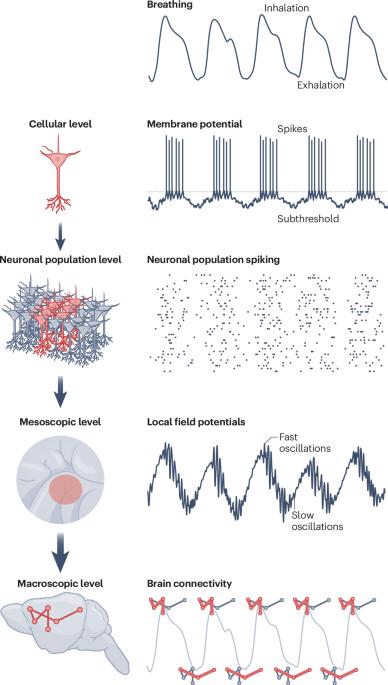呼吸周期对大脑活动的全面协调
IF 26.7
1区 医学
Q1 NEUROSCIENCES
引用次数: 0
摘要
与呼吸节奏同步的神经元活动已经在人类和许多哺乳动物物种中被发现,不仅在与呼吸控制或嗅觉编码密切相关的大脑区域,而且在与情绪和高级认知功能相关的区域。与此同时,呼吸循环调节感知和行动的证据也越来越多。在这篇综述中,我们讨论了大脑活动锁定呼吸的程度,组织水平和大脑状态,以及这种全球同步的生理起源。我们描述了鼻腔气流引起的感觉活动波如何通过脑回路传播,使神经元群与呼吸周期同步,并调节更快的振荡、细胞组装形成和跨区域通信,从而提供了从呼吸到神经编码、情感和认知的机制联系。我们认为,通过进化,呼吸节奏已经形成了跨物种的网络功能。本文章由计算机程序翻译,如有差异,请以英文原文为准。


Global coordination of brain activity by the breathing cycle
Neuronal activities that synchronize with the breathing rhythm have been found in humans and a host of mammalian species, not only in brain areas closely related to respiratory control or olfactory coding but also in areas linked to emotional and higher cognitive functions. In parallel, evidence is mounting for modulations of perception and action by the breathing cycle. In this Review, we discuss the extent to which brain activity locks to breathing across areas, levels of organization and brain states, and the physiological origins of this global synchrony. We describe how waves of sensory activity evoked by nasal airflow spread through brain circuits, synchronizing neuronal populations to the breathing cycle and modulating faster oscillations, cell assembly formation and cross-area communication, thereby providing a mechanistic link from breathing to neural coding, emotion and cognition. We argue that, through evolution, the breathing rhythm has come to shape network functions across species. Synchrony between neuronal activity and the respiratory cycle has been observed in numerous brain regions and across many species. Tort et al. discuss the mechanisms by which brain activity is modulated by breathing and describe the functional impact of this synchrony on perception and cognition.
求助全文
通过发布文献求助,成功后即可免费获取论文全文。
去求助
来源期刊

Nature Reviews Neuroscience
NEUROSCIENCES-
自引率
0.60%
发文量
104
期刊介绍:
Nature Reviews Neuroscience is a multidisciplinary journal that covers various fields within neuroscience, aiming to offer a comprehensive understanding of the structure and function of the central nervous system. Advances in molecular, developmental, and cognitive neuroscience, facilitated by powerful experimental techniques and theoretical approaches, have made enduring neurobiological questions more accessible. Nature Reviews Neuroscience serves as a reliable and accessible resource, addressing the breadth and depth of modern neuroscience. It acts as an authoritative and engaging reference for scientists interested in all aspects of neuroscience.
 求助内容:
求助内容: 应助结果提醒方式:
应助结果提醒方式:


